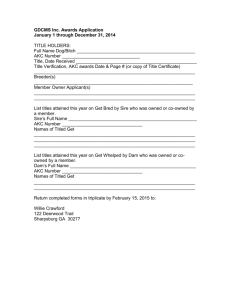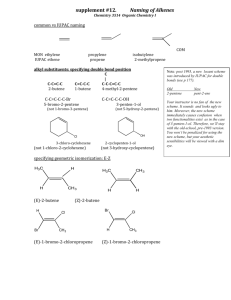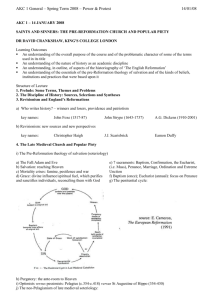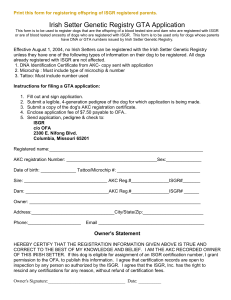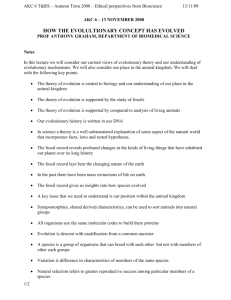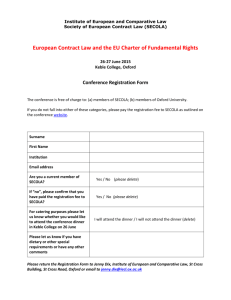Lecture 8 - King`s College London
advertisement
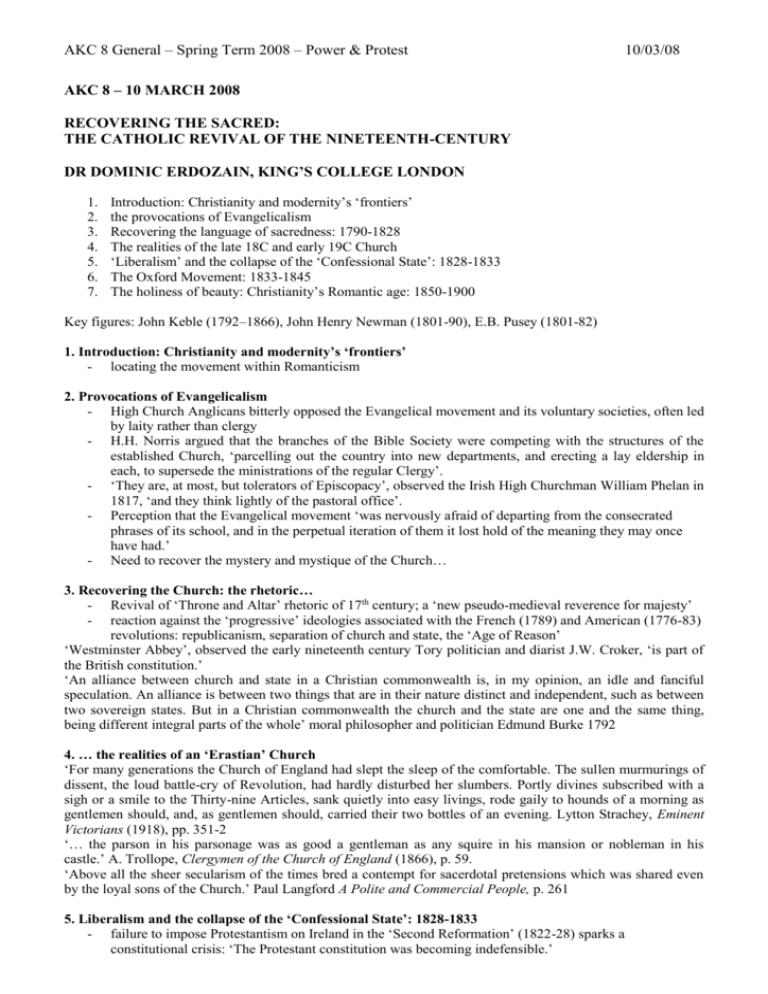
AKC 8 General – Spring Term 2008 – Power & Protest 10/03/08 AKC 8 – 10 MARCH 2008 RECOVERING THE SACRED: THE CATHOLIC REVIVAL OF THE NINETEENTH-CENTURY DR DOMINIC ERDOZAIN, KING’S COLLEGE LONDON 1. 2. 3. 4. 5. 6. 7. Introduction: Christianity and modernity’s ‘frontiers’ the provocations of Evangelicalism Recovering the language of sacredness: 1790-1828 The realities of the late 18C and early 19C Church ‘Liberalism’ and the collapse of the ‘Confessional State’: 1828-1833 The Oxford Movement: 1833-1845 The holiness of beauty: Christianity’s Romantic age: 1850-1900 Key figures: John Keble (1792–1866), John Henry Newman (1801-90), E.B. Pusey (1801-82) 1. Introduction: Christianity and modernity’s ‘frontiers’ - locating the movement within Romanticism 2. Provocations of Evangelicalism - High Church Anglicans bitterly opposed the Evangelical movement and its voluntary societies, often led by laity rather than clergy - H.H. Norris argued that the branches of the Bible Society were competing with the structures of the established Church, ‘parcelling out the country into new departments, and erecting a lay eldership in each, to supersede the ministrations of the regular Clergy’. - ‘They are, at most, but tolerators of Episcopacy’, observed the Irish High Churchman William Phelan in 1817, ‘and they think lightly of the pastoral office’. - Perception that the Evangelical movement ‘was nervously afraid of departing from the consecrated phrases of its school, and in the perpetual iteration of them it lost hold of the meaning they may once have had.’ - Need to recover the mystery and mystique of the Church… 3. Recovering the Church: the rhetoric… - Revival of ‘Throne and Altar’ rhetoric of 17th century; a ‘new pseudo-medieval reverence for majesty’ - reaction against the ‘progressive’ ideologies associated with the French (1789) and American (1776-83) revolutions: republicanism, separation of church and state, the ‘Age of Reason’ ‘Westminster Abbey’, observed the early nineteenth century Tory politician and diarist J.W. Croker, ‘is part of the British constitution.’ ‘An alliance between church and state in a Christian commonwealth is, in my opinion, an idle and fanciful speculation. An alliance is between two things that are in their nature distinct and independent, such as between two sovereign states. But in a Christian commonwealth the church and the state are one and the same thing, being different integral parts of the whole’ moral philosopher and politician Edmund Burke 1792 4. … the realities of an ‘Erastian’ Church ‘For many generations the Church of England had slept the sleep of the comfortable. The sullen murmurings of dissent, the loud battle-cry of Revolution, had hardly disturbed her slumbers. Portly divines subscribed with a sigh or a smile to the Thirty-nine Articles, sank quietly into easy livings, rode gaily to hounds of a morning as gentlemen should, and, as gentlemen should, carried their two bottles of an evening. Lytton Strachey, Eminent Victorians (1918), pp. 351-2 ‘… the parson in his parsonage was as good a gentleman as any squire in his mansion or nobleman in his castle.’ A. Trollope, Clergymen of the Church of England (1866), p. 59. ‘Above all the sheer secularism of the times bred a contempt for sacerdotal pretensions which was shared even by the loyal sons of the Church.’ Paul Langford A Polite and Commercial People, p. 261 5. Liberalism and the collapse of the ‘Confessional State’: 1828-1833 - failure to impose Protestantism on Ireland in the ‘Second Reformation’ (1822-28) sparks a constitutional crisis: ‘The Protestant constitution was becoming indefensible.’ AKC 8 General – Spring Term 2008 – Power & Protest - - 10/03/08 1828 Dissenters officially admitted to public office (Repeal of Test and Corporation Acts) For Lord John Russell, it was ‘a gratifying thing to force the enemy to give up his first line, that none but Churchmen are worthy to serve the State, and I trust we shall soon make him give up the second, that none but Protestants are.’ 1829 ‘Catholic Emancipation’ crisis sees end of Tory dominance, arrival of progressive Whig party, who reform electoral system and start to reform the Church From emancipation to endorsement? The 1833 Irish Church Bill as tipping point: government abolishes 10 out of 22 Irish bishoprics in radical overhaul of Church of England in Ireland John Keble, the poet of The Christian Year, asserted in March 1833 that the Irish Church Bill signalled that the ‘persecution of the church has begun’ 6. The Oxford Movement - 14 July 1833 Keble delivered his famous Assize Day Sermon in the University Pulpit of Oxford: argued that the ‘Apostolical Church’ faced being ‘forsaken, degraded, nay trampled on and despoiled by the State and people of England’ in an act of ‘national apostasy’ - Church must be prepared to give up its tithes and endowments in order to preserve its character as a Christian Church - August 1833, the Apostolicals began issuing the ‘Tracts for the Times’ that gave a name to their movement ‘Are we content to be accounted the mere creation of the State, as schoolmasters and teachers may be, or soldiers, or magistrates, or other public officers? Did the State make us? can it unmake us? can it send out missionaries? can it arrange dioceses? Surely all these are spiritual functions; and Laymen may as well set about preaching, and consecrating the LORD’S Supper, as assume these.’ The Catholic Church, Tract 2, (1833), p. 2. - In Tract 4 Keble echoed Newman’s claim that the established clergy had lost sight of their true commission, and that the Church might be more effective if liberated from the State connection. - theme of returning to the purity of the ancient, pre-Constantinian Church - Fiercely resisted admission of Dissenters to Oxford in 1835 - Newman: how could the colleges allow ‘our places of worship to be profaned by the presence of those who scorn them?’ - Revival of interest in early church and Middle Ages - The Parting of Friends: Newman’s research into the early church raises the question that CofE might be a schismatic movement, and the RC Church might be the true Church - First major attack: 1836 Thomas Arnold’s Edinburgh Review article, ‘The Oxford Malignants’ - Tract 90: in 1841 Newman tried to halt secession from the Church to RC by arguing that 39 Articles can be interpreted in Catholic Sense - ‘It caused a sensation and prompted his enemies to commence the fight-back’ - 1845: Newman converted to Rome and began studying for the priesthood. He became Cardinal in 1879 - between 1854 and 1900 about 450 Anglican clergymen, as well as more than seventy peers and peeresses, followed Newman to Rome. (Hilton, 471) - Pusey stayed in CofE – inspired generation of ‘slum priests’ – great tradition of social service 7. The holiness of beauty: Christianity’s Romantic age: 1850-1900 - Along with the interest in antiquity, the Tractarians were drawn to the medieval Church - Revived interest in Gothic architecture: 1839 Cambridge Camden Society formed to promote ‘ecclesiology’, or ‘the principles which guided medieval builders’ - Neo-Gothic becomes pattern of 19C church building Further reading: Rosman, D., The Evolution of the English Churches 1500-2000 (2003) Full details about the AKC course, including copies of the handouts, can be found on the AKC website at: http://www.kcl.ac.uk/akc. Please join in the Discussion Board and leave your comments. If you have any queries please contact the AKC Course Administrator on ext 2333 or via email at dean@kcl.ac.uk. The AKC Exam is on Monday 21 April 2008 between 14.30 and 16.30. You must register for the course, using the form on the website, before registering for the exam. EXAM REGISTRATION is now open. Please reply to the email you will have received giving your full name and student ID number. The deadline for AKC exam registration is Thursday 20 March 2008.
